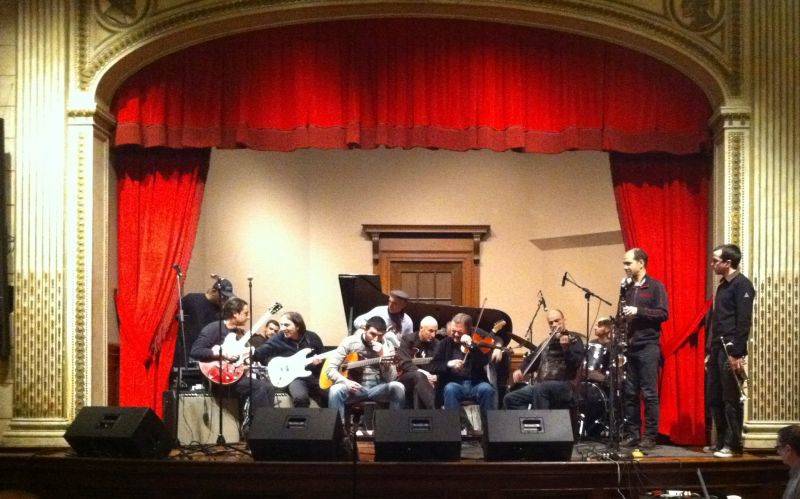Improvvisatore Involontario Plays at Columbia
On the second floor of the Italian Academy at Columbia University, there is a large concert room, with hardwood floors and large decorated windows. The stage, adorned with large red velvet curtains, imposed a classical ambiance and a mood of grandeur. On March 9th, however, the musicians backstage had a very different agenda from past classical musical productions and operas that had taken the stage before them. The night would be governed by improvisation.
Improvvisatore Involontario began their program around 8:30 pm and for two hours, filled the room with unsuspecting rhythms, tonal conjunctions, syncopations, and vocal vibrations. Musicians demonstrated a strong understanding of a very particular genre of musical composition; one which balances expertise and impromptu innovation.
In the first of three sets, entitled “Heimweh,” Alessandro Salerno on baritone guitar and Alberto Popolla on bass clarinet introduced a necessary element to the performance. Before they began, the large room was silent. The two musicians situated their sheet music and smiled at one another. They knew that for the next twenty minutes, although there would be several moments of coordination, their performance would be driven by tonal and rhythmic dissonance.
In the second piece, the less modest of the two, Popolla held onto long, imposing chords while Salerno stretched the limits of improvisation. He worked with swift melodic lines, and intriguing hand tricks, moving under and over the guitar to grab and slap the notes he wanted. He was getting the same crisp rifts, using completely unconventional hand position and technique. If you weren’t thoroughly pleased by Popolla’s impressive high-pitched tones in the first piece, Salerno would have provided the visual entertainment in the second.
After a quick set change, four new members came to the stage and sat in a semi-circle formation. This angle was necessary as each musician in the electric guitar quartet, Tetraktys, would need to make eye-contact with the others for cues. Introducing the quartet and their mission was guitarist and composer, Paolo Sorge. He began speaking about his quartet in a quiet, humble voice, perhaps nervous to express himself in English. This apprehension vanished immediately, however, once Sorge called out the first syncopation. The quartet broke ground into their set with poise and polished creativity.
The members of the quartet, Enrico Cassia, Fabrizio Licciardello, Marco Capelli, and Paolo Sorge, although they met sporadically in moments of melodic unity, were very much in their own zone throughout the performance. Their transitions were smooth and unnoticeable. Facial expressions and cues from Sorge opened the floor for solo’s, one of which Cappelli, in the third piece, took full advantage. In a highly energetic and engaging method, Cappelli used intense tremor-like movements up the scale. In due time, Sorge brough the quartet back into focus. The audience expressed regret that Tetraktys’ set had come to a close.
For the third and final set, featuring Naked Musicians, the stage filled to its utmost capacity with electric guitars, drum sets, strings, woodwinds, and many more music stands. The audience was also introduced to a new feature with this ensemble, conductor and musician, Francesco Cusa--an indispensable presence. He summoned sections of the orchestra, invoked individual instruments, changed volumes and intensities with vertical arm motions, and created accordion-like crescendos with horizontal hand motions. The ensemble was transformed into a living, breathing, beast; Cusa made sure of it.
In addition to Cusa’s unique conducting style, Naked Musicians contained another element that further separated their project from traditional jazz ensembles. On the far left of the stage were two women, recruited for their vocal agility and eclectic style. Gaia Mattiuzzi and Cristina Zavalloni used their vocal chords to decorate the sonorous palate with high-pitch operatic scales, screeching vibrato, aimless commentary, and erratic animal-like tones. Some of their pieces resembled percussion sounds, and it was clear that the two were having fun stretching limits with their vocal chords. Some members of the audience, perhaps unaccustomed to this element of improvisation, glanced at one another when the women began their beat-boxing and pained whining sounds, but the soloists were unstoppable. Their role in the ensemble was a striking and integral element of the performance.
As the concert came to an end, it was clear that the musicians were exhausted and the audience, satisfied. The performance on March 9th brought something unusual and extraordinary to Columbia University’s Casa Italiana. Improvvisatore Involontario continues to mix creativity with expertise, adding a new Italian voice to the canon of contemporary jazz.




































i-Italy
Facebook
Google+
This work may not be reproduced, in whole or in part, without prior written permission.
Questo lavoro non può essere riprodotto, in tutto o in parte, senza permesso scritto.